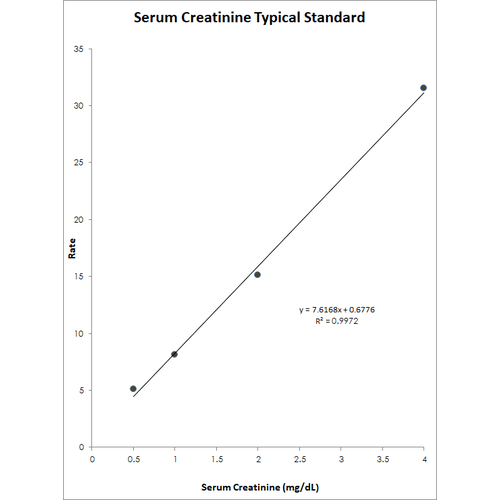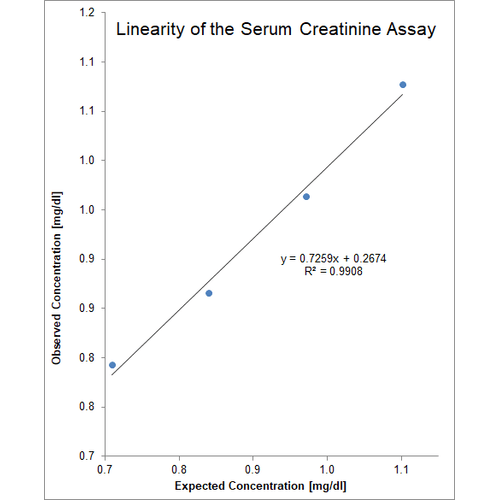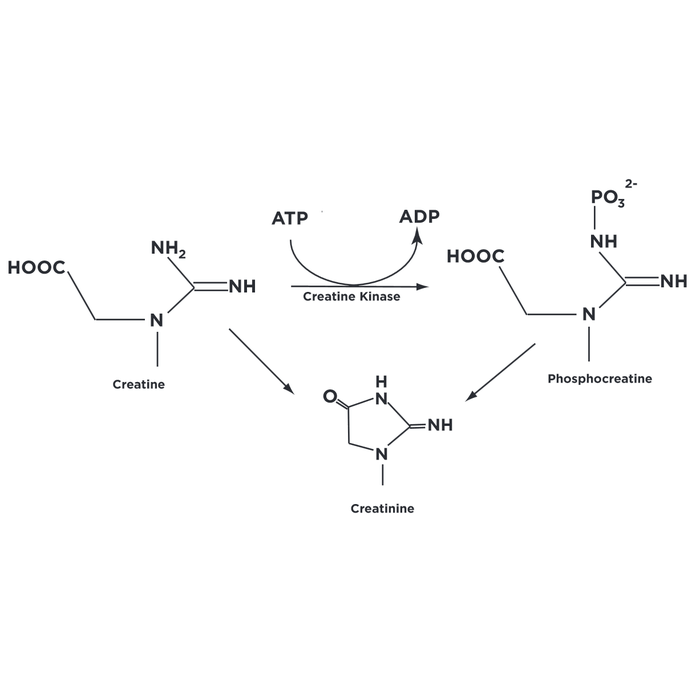SKT-217-192
StressXpress® Creatinine Serum Detection Kit
Stressmarq Biosciences
Image

Image

Image

DETAILS
- Item: Clear 96 well Half Area Plates | Creatinine Standard | Assay Diluent | StressXpress® Creatinine Reagent
- Target: Creatinine Serum
- Utility: Colorimetric assay used to measure creatinine in samples.
- Category: Assay Kits
- Platform: Microplate
- Precision: Intra Assay Precision: Four human serum samples were run in triplicate on a same-day assay determined that the mean and precision of the calculated concentrations were: Sample 1- 0.75 mg/dL, 5% CV Sample 2- 0.78 mg/dL, 6% CV Sample 3- 0.6 mg/dL, 4% CV Sample 4- 0.76 mg/dL, 6% CV Inter Assay Precision: Four human serum samples were run in triplicate on a same-day assay determined that the total range of 4-6% represents the variation between different assays.
- Assay Type: Direct Quantitative Assay
- References: 1. Wallimann, T. et al., Biochem. J., 2000, 281, 21-40. 2. Wyss, M. and Kaddurah-Daouk, R., Physiol. Rev., 2000, 80, 1107-1213. 3. Raja Iyengar, M. et al., J. Biol. Chem, 1985, 260, 7562-7567. 4. Manjunath, G. et al., Postgrad. Med. 2001, 110, 55-62. 5. Gross, J.L. et al., Diabetes Care, 2005, 28, 164-176. 6. Anavekar, N.S. et al., New Engl. J. Med., 2004, 351, 1285-1295.
- Assay Range: 0.5 - 4 mg/dl
- Description: Colorimetric measurement of creatinine
- Sensitivity: 0.085 mg/dl
- Component No: SKC-217A | SKC-217B | SKC-217C | SKC-217D
- Field of Use: Not for use in humans. Not for use in diagnostics or therapeutics. For in vitro research use only.
- Net Weight G: 300
- Product Type: Detection Kits
- Sample Types: Serum | Plasma
- Stock Product: Y
- Assay Overview: The Creatinine Serum Detection Kit is designed to quantitatively measure creatinine present in serum samples. A creatinine standard, calibrated to a creatinine standard, is provided to generate a standard curve for the assay and all samples should be read off the standard curve. Standards or samples are pipetted into a clear microtiter plate. An assay diluent is added to all standards, controls and samples. The color generating reaction is initiated with the StressXpress® Creatinine Reagent, which is pipetted into each well. The assay utilizes a kinetic absorbance method to overcome interference by colored compounds in serum. The absorbance of the colored product is read in a microtiter plate reader capable of measuring 490nm wavelength. For a total of 30 minutes, the optical density is read at 1 minute intervals. The concentration of creatinine is calculated using the Kinetic Mode software and samples are compared to the curve generated from the standards, or by using the Excel worksheet available for free download at our web site. The Jaffe reaction used in this kit has been modified to read creatinine levels in serum (8).
- Quantity Size: 2 Plates | 100 µl | 6 ml | 20 ml
- Research Areas: Cell Signaling | Cardiovascular System
- Gross Weight Kg: 2
- Detection Method: Colorimetric Assay
- Alternative Names: N-Carbamimidoyl-N-methylglycine Detection Kit, Methylguanidoacetic acid Detection Kit
- Cite This Product: Creatinine Serum Detection Kit (StressMarq Biosciences, Canada, Cat # SKT-217-192)
- Country of Origin: Canada
- Number of Samples: 91 samples in duplicate
- Storage Temperature: 4ºC
- Shipping Temperature: Blue Ice
- Scientific Background: Creatinine (2-amino-1-methyl-5H-imadazol-4-one) is a metabolite of phosphocreatine (p-creatine), a molecule used as a store for high-energy phosphate that can be utilized by tissues for the production of ATP (1). Creatine either comes from the diet or synthesized from the amino acids arginine, glycine, and methionine. This occurs in the kidneys and liver, although other organ systems may be involved and species-specific differences may exist (2). Creatine and p-creatine are converted non-enzymatically to the metabolite creatinine, which diffuses into the blood and is excreted by the kidneys. In vivo , this conversion appears to be irreversible and in vitro it is favored by higher temperatures and lower pH2. Creatinine forms spontaneously from p-creatine (3). Under normal conditions, its formation occurs at a rate that is relatively constant and as intra- individual variation is <15% from day to day, creatinine is a useful tool for normalizing the levels of other molecules found in urine. Additionally altered creatinine levels may be associated with other conditions that result in decreased renal blood flow such as diabetes and cardiovascular disease (4-6).
- Species Reactivity Medium: Human | Mouse | Rabbit | Rat | Sheep
- Species Reactivity Full Name: Human | Mouse | Rabbit | Rat | Sheep
DESCRIPTION
Colorimetric measurement of creatinine